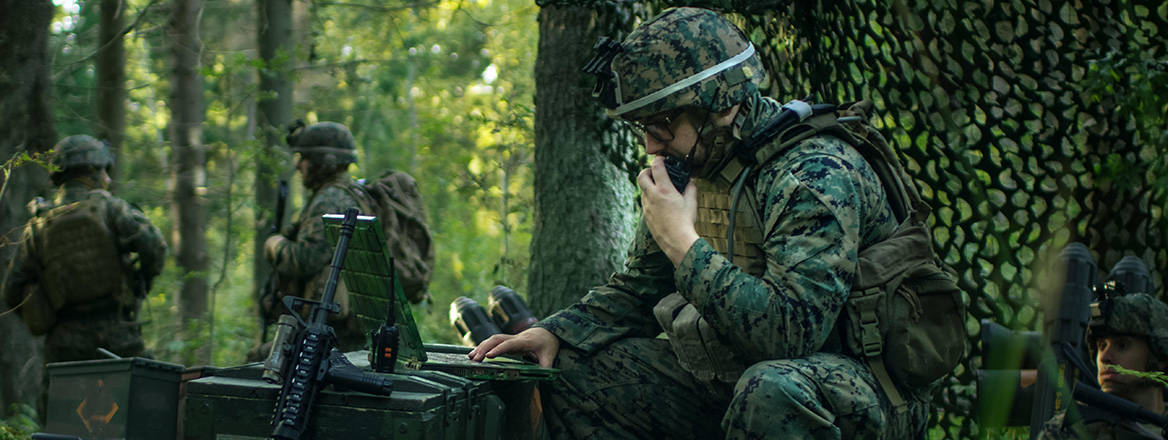The Strategic Defence Review places cyber and electronic warfare centre-stage but it remains unclear how ambitions on the digital battlefield will be resourced.
The forthcoming UK Cyber and Electromagnetic Command (CyberEM) outlined in the Strategic Defence Review could be a much-needed pillar of modernisation. It follows a line of thinking, pre-dating Russia’s 2022 Ukraine invasion, where electronic warfare (characterised by rigid hardware) and cyber operations are increasingly entwined.
If the past is a guide, we have a long way to go. Four years ago, Future Soldier promised to boost the Army’s electronic warfare (EW) capability ‘100%’, while UK doctrine from 2018 highlights the ‘imperative’ to master the ‘convergence’ of cyber and electromagnetic activities (CEMA).
This has not translated into reality, either in equipment or training. A well-identified problem is a lack of digital skills not only in the MOD but across the defence industry. Plans to address this may not be bold enough.
Ukraine’s CEMA lessons pose worrying questions for the command if the British Army faced a ‘fight tonight’ scenario. The problem is attracting talent while upskilling CEMA personnel in the Army – which could lose operators to ‘the domain lead’, CyberEM Command. For this new vision, the pipeline for specialists is thin, with 32 scheduled for training at Shrivenham this year. For context, 13 Signal Regiment was re-formed around a core of roughly 250 specialists. For the new “cyber pipeline” at Shrivenham, “recruitment into cyber roles in 2025 will initially be through the Royal Navy and Royal Air Force, with the British Army joining for subsequent recruitment campaigns from early 2026.”
CyberEM Command will deploy contractors to conflicts as a Digital Warfighter Group alongside soldiers. Bolstering Army generalist ability and specialisation in this field has been identified as a serious near-term problem, so it is vital that this fundamental requirement is not lost amid reorganisation.
While many cyber activities will be conducted far from the front, there is wide agreement that specialists will be in high demand for expeditionary operations
Why does this matter? Soldiers must be, at a minimum, aware that the moment of a cyberattack, from disrupting rail transit to the Baltics to a glitch in a wide area network, could preclude kinetic effects.
Moreover, Unmanned Aerial Systems, deployed in swarms to stream intelligence to commanders, can be hacked ‘over the air.’ UAS cyber exploitation can be avoided with vigilance, but it is an evolving risk. The US is now interested in cyber payloads delivered in radio frequency attacks, degrading or compromising battle networks, and how to defend against this. This capability has long existed in the air domain and was seen in Ukraine when Russian hackers Fancy Bear compromised an early version of a Ukrainian app for artillery in the Donbas – with lethal effect – while Ukraine’s Delta system has been repeatedly targeted. Our networks will hopefully be more robust, but our adversaries will be more capable.
While many cyber activities will be conducted far from the front, much of it by civilian contractors, and CEMA equipment is increasingly user friendly, there is wide agreement that specialists will be in high demand for expeditionary operations.
This is because ‘software-defined warfare’ relies on increasing amounts of deployed hardware, such as the Trinity Wide Area network nodes that could be fitted to Boxer armoured vehicles as part of the Digital Targeting Web (DTW).
Low latency of these networks cannot be assumed. US Marines have reported many hours of struggle coordinating with contractors working in shifts at far away hubs while deploying battlefield networks. In a peer conflict, Royal Signals personnel will be working around the clock on the engineering and cyber side of operations to maintain communications as forces move. Meanwhile, even ruggedised computers can fail in austere environments. The deployable Digital Warfighter Group is logical, but we need more army specialists, not just ‘button pushers’.
In communications, technology is opening doors. CEMA is increasingly implemented through reprogrammable digital systems while software-defined radios ‘hop’ frequencies 1000s of times a second and spread signals across the spectrum to thwart interception and jamming. CEMA equipment is getting more portable, powerful and ‘cognitive’.
The effort now is to fuse a vast array of new and emerging systems and tactics on an extremely short timeline, including replacing obsolete equipment like the Bowman radio, if Britain is to stand up its DTW by 2027.
Orchestrating the Cyber Domain
CyberEM Command therefore has an important ‘cohering’ role, discussed in the SDR. An increasing number of compact EW systems can be mounted on manned aircraft, drones or ground vehicles to disrupt attacks through deception, attack (to blind adversaries) or a combination of EW and kinetic effects, passively seeking and destroying radars and GPS jammers. However, tactics constantly evolve and opponents can modify antennas to harden against jamming.
The SDR describes the need for ‘the Integrated Force to fuse the disparate CyberEM activity of a small number of expert organisations’ and that the CyberEM Command would be the ‘single point of authority’. The SDR says that “where cyber effects must be aligned as part of military operations, this integration will remain the responsibility of the relevant joint commander.”.
What might alignment involve? Under Project ASGARD, which focuses on reconnaissance and strike, the Army is procuring drones from Modini. Their Dart 250 EW has a passive sensor to seek enemy radars, potentially complementing the RAF Stormshroud which has a software-defined payload that creates false radar returns. This could enable Joint Suppression and Destruction of Enemy Air Defences (JSEAD/DEAD) to create overlapping effects.
Civilian contractors will play a core role in the Digital Targeting Web
On this increasingly complex battlefield, a liaison role for CyberEM Command will allow centralised ‘decision making for authorities to reduce duplication and reduce inefficiency’. It will be critical to track new multidomain systems and tactics. For example, the DIGAR anti-GNSS jamming platform was originally intended for manned aircraft but was reconfigured for use in Ukraine, hardening HIMARS against Russian GNSS jamming.
These examples show the need for wider ‘spectrum awareness’ across the force, and the potential it could unlock. But before CyberEM Command can ‘cohere’ and ‘align’ we need enough Army specialists.
The CyberEM Startup
CyberEM is intended to aid how ‘defence understands, develops and accesses capability with allies and industry’. Civilian contractors will play a core role in the DTW, requiring highly motivated talent, including experts in encryption and AI from the private sector and reservists in the Specialist Group Information Services. A ‘Spectrum Coordination Office’ will support civil-military cooperation to this end, but realising this goal may come down to attracting talent in-house, as much as partnering with industry.
Increasingly, AI will be incorporated into our systems. The Command’s Cyber Direct Entry programme offers applicants £40,000 starting salary with £25,000 ‘in additional skills pay’. This is a good start - according to Glassdoor, the average salary for a cyber security specialist in London is £51,000, however according to the LSE, the median advertised salary for AI engineers in the capital is £87,500.
The need for specialists sits uneasily with the tight timeline for the DTW: Trinity is due to replace the Falcon internet system next year. The Boxer, potentially fitted with Trinity, may not be ready in meaningful numbers. We may also be moving to the ability to reprogram equipment for almost any enemy EMS tactic in near real time, through US experimental projects such as the Rapid Effects Generation Enterprise and Arsenal. This is implemented at the battlefield tactical edge, not remotely.
Eighteen years after the first publicly reported cyber-EMS attack, Israel’s strike on an incomplete nuclear reactor in Syria (thought to be a joint operation between the Israeli Air Force and Unit 8200) the UK is finally close to a CEMA strategy fit for modern war. It comes, by some accounts, after decades where the Army has fallen behind on EW capabilities. We cannot afford similar delays on the rapidly changing modern battlefield. For CyberEM Command to truly fulfil its role, it needs to be properly resourced, for training capacity, staff retention and career development opportunities.
© RUSI, 2025.
The views expressed in this Commentary are the authors', and do not represent those of RUSI or any other institution.
For terms of use, see Website Terms and Conditions of Use.
Have an idea for a Commentary you'd like to write for us? Send a short pitch to commentaries@rusi.org and we'll get back to you if it fits into our research interests. View full guidelines for contributors.
WRITTEN BY
Robert Tollast
Research Fellow, Land Warfare
Military Sciences
- Jim McLeanMedia Relations Manager+44 (0)7917 373 069JimMc@rusi.org



